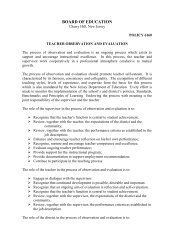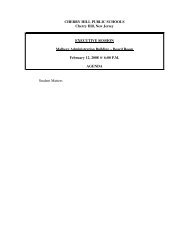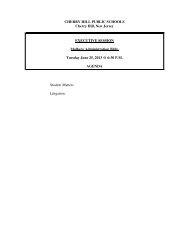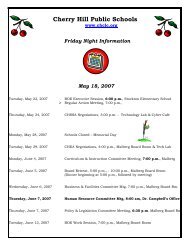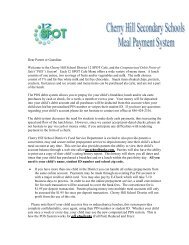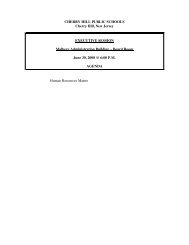PDF - Cherry Hill Public Schools
PDF - Cherry Hill Public Schools
PDF - Cherry Hill Public Schools
You also want an ePaper? Increase the reach of your titles
YUMPU automatically turns print PDFs into web optimized ePapers that Google loves.
CLASSROOM TEACHER:<br />
CHERRY HILL PUBLIC SCHOOLS<br />
<strong>Cherry</strong> <strong>Hill</strong>, New Jersey<br />
ANNUAL PERFORMANCE REPORT<br />
TENURED CLASSROOM TEACHER<br />
Grade or Area:<br />
Years in <strong>Cherry</strong> <strong>Hill</strong>:<br />
School:<br />
Years in Teaching:<br />
Annual Summary Conference Date<br />
Completed by May 15 th (Submitted by June 15 th )<br />
Classroom Teacher's Signature<br />
Date<br />
Principal's Signature<br />
Date<br />
Supervisor's Signature<br />
Date<br />
Teacher Comments Attached (Check if yes)<br />
List of Observations:<br />
___________________________________<br />
1 st Submitted by April 30 th<br />
_________________________________<br />
___________________________________<br />
_________________________________<br />
___________________________________<br />
_________________________________
<strong>Cherry</strong> <strong>Hill</strong> <strong>Public</strong> <strong>Schools</strong><br />
Annual Performance Report (Tenured and Non-Tenured)<br />
* First year teachers are working towards this indicator but mastery is not expected.<br />
** First and second year teachers are working towards this indicator but mastery is not<br />
expected.<br />
Planning and Preparation<br />
The teacher plans challenging and appropriate instructional goals/objectives<br />
incorporating the Principles of Learning and the <strong>Cherry</strong> <strong>Hill</strong> Standards.<br />
Learning activities are developed from essential questions with the final<br />
assessment in mind. <br />
The teacher can articulate how instructional goals create academic rigor,<br />
socialize intelligence and relate to the <strong>Cherry</strong> <strong>Hill</strong> Essential Curriculum. *<br />
The teacher creates opportunities for students to develop and demonstrate<br />
ethical and responsible behavior.<br />
The teacher demonstrates knowledge of curriculum, content, pedagogy and resources.<br />
The teacher conveys high expectations for student achievement by<br />
planning rigorous instructional goals and activities.<br />
The teacher’s plans and practices reflect an understanding of the content<br />
of the discipline and relationships among concepts and topics.<br />
The teacher creates interdisciplinary learning experiences that allow<br />
students to integrate knowledge, skills, and methods of inquiry from<br />
several disciplines. *<br />
The teacher evaluates and selects teaching resources for accuracy,<br />
comprehensiveness, and usefulness to enhance instruction and support<br />
student learning.<br />
The teacher uses technology to enhance teaching and learning.<br />
The teacher demonstrates knowledge of students.<br />
The teacher displays understanding of developmental characteristics as<br />
well as the skills and knowledge of each student.<br />
The teacher’s plans take into account varying learning styles of individual<br />
students or groups through differentiated instruction. **<br />
The teacher effectively assesses student learning.<br />
Assessment tools are fair, credible, and aligned with the <strong>Cherry</strong> <strong>Hill</strong><br />
Standards and Essential Curriculum.<br />
The assessment criteria and standards have been clearly communicated to<br />
students (for example, through coaching rubrics, scoring rubrics, models<br />
of student work, etc.).<br />
The teacher offers students opportunities for self-assessment and<br />
reassessment to monitor and manage the quality of their leaning.
The teacher creates, selects, and utilizes a variety of formative and<br />
summative assessments that provide information about student learning<br />
and inform instructional decisions.<br />
Evidence/Artifacts: A least one piece of evidence/artifacts from this domain will be<br />
agreed upon between teacher and supervisor (this could vary from school to school)<br />
Ex: Unit plans, Assessments, Rubrics, Student Data Collection<br />
Areas of Strength:<br />
Areas of Growth:<br />
Areas of Concern:<br />
Classroom Environment<br />
The teacher creates an environment of respect and rapport.<br />
The teacher demonstrates genuine caring and respect for individual<br />
students.<br />
The teacher creates a positive classroom climate that is socially,<br />
emotionally and physically safe.<br />
The teacher communicates in ways that demonstrate sensitivity to cultural,<br />
gender, and linguistic differences.<br />
The teacher establishes a culture for learning.<br />
The teacher demonstrates enthusiasm for the subject and conveys its<br />
importance to students.<br />
The teacher communicates to all students that they are already competent<br />
learners and are able to become even better through their persistent use of<br />
strategies and by reflecting on their efforts. (Socializing Intelligence)<br />
The teacher creates a learning community of mutual respect, in which<br />
students participate in decision-making and work collaboratively.<br />
The teacher recognizes accomplishment by celebrating individual student<br />
work (for example, through classroom and hallway displays, publications,<br />
verbal and written feedback, etc.). (Recognition of Accomplishment)<br />
The teacher manages classroom procedures effectively.<br />
Tasks and materials are organized and managed so students are engaged<br />
and productive.<br />
Transitions occur smoothly with minimal loss of instructional time.
The teacher appropriately and proactively manages student behavior.<br />
Standards of conduct are clear to all students.<br />
The teacher is consistently alert to student behavior.<br />
The teacher’s response to misbehavior is appropriate, consistent, and<br />
respectful of students’ dignity.<br />
Evidence/Artifacts: A least one piece of evidence/artifacts from this domain will be<br />
agreed upon between teacher and supervisor (this could vary from school to school)<br />
Ex: Classroom Code of Contact<br />
Areas of Strength:<br />
Areas of Growth:<br />
Areas of Concern:<br />
Instruction<br />
The teacher communicates clearly and accurately.<br />
The teacher’s objectives, directions, procedures, and expectations are<br />
made clear to students.<br />
The teacher’s spoken and written language is clear and correct.<br />
Vocabulary is appropriate to students’ age, abilities, and interests.<br />
The <strong>Cherry</strong> <strong>Hill</strong> Standards and Benchmarks are clearly expressed to<br />
students.<br />
Feedback to students is meaningful and provided in a timely manner.<br />
The teacher promotes learning through accountable classroom talk.<br />
The teacher develops in students the skills of Accountable Talk.<br />
The teacher uses instructional strategies, such as questioning and<br />
discussion techniques, to engage all students and foster inquiry. <br />
The teacher engages students in varied experiences that meet diverse needs and<br />
promote social, emotional and academic growth.<br />
Content is appropriate and captures key ideas that link with students’ prior<br />
knowledge and experience.<br />
The teacher engages students in purposeful, challenging, learning<br />
activities that help them use higher order thinking skills.<br />
The teacher creates learning experiences that make subject matter<br />
meaningful for students, for example, by encouraging students to pursue<br />
their own interests and inquiries and by helping students connect their<br />
learning to personal goals and real-life situations.
The teacher provides opportunities for students to generate essential<br />
questions and to initiate or adapt activities and projects to enhance<br />
understanding. *<br />
Instructional groups are created to meet the goals of a lesson.<br />
The lesson has a clearly defined structure including a meaningful<br />
introduction and closing activity.<br />
Additional instruction and learning time is provided to support students in<br />
meeting the standards.<br />
The teacher demonstrates flexibility and responsiveness to students’ needs.<br />
The teacher accommodates students’ questions or interests and takes<br />
advantage of “teachable moments.”<br />
The teacher persists in seeking effective approaches for all students by<br />
using a repertoire of strategies, including reassessment. *<br />
Evidence/Artifacts: A least one piece of evidence/artifacts from this domain will be<br />
agreed upon between teacher and supervisor (this could vary from school to school)<br />
Ex: Student work with rubric, Interdisciplinary Unit<br />
Areas of Strength:<br />
Areas of Growth:<br />
Areas of Concern:<br />
Professional Responsibility<br />
The teacher contributes to the school and district.<br />
Support, trust, cooperation, and collaboration characterize relationships<br />
with colleagues.<br />
The teacher shows willingness to participate in school and district<br />
activities.<br />
The teacher thinks systematically about teaching practice and learns from experience.<br />
The teacher uses classroom observation, information about students,<br />
pedagogical knowledge, and research as resources for active reflection,<br />
evaluation, and revision of practice.<br />
The teacher takes advantage of opportunities for professional development<br />
to enhance content knowledge, pedagogical skill, and the use of best<br />
practices.<br />
The teacher maintains accurate records.<br />
The teacher develops an effective system for maintaining data on student<br />
completion of assignments, student progress in learning and noninstructional<br />
activities.
The teacher communicates with families.<br />
The teacher provides frequent information to parents about the<br />
instructional program.<br />
The teacher communicates with sensitivity to parents about student<br />
progress.<br />
The teacher shows professionalism.<br />
The teacher is proactive in seeking out resources when necessary.<br />
The teacher advocates for his/her students’ best interests.<br />
The teacher employs appropriate intervention strategies.<br />
The teacher is receptive and flexible when participating in decision<br />
making.<br />
The teacher is responsive to all professional duties and responsibilities.<br />
Ex: Parent Contact Evidence, School and/or District activities, Grade book.<br />
Areas of Strength:<br />
Areas of Growth:<br />
Areas of Concern:<br />
Pupil Progress:<br />
Professional Development Plan:



